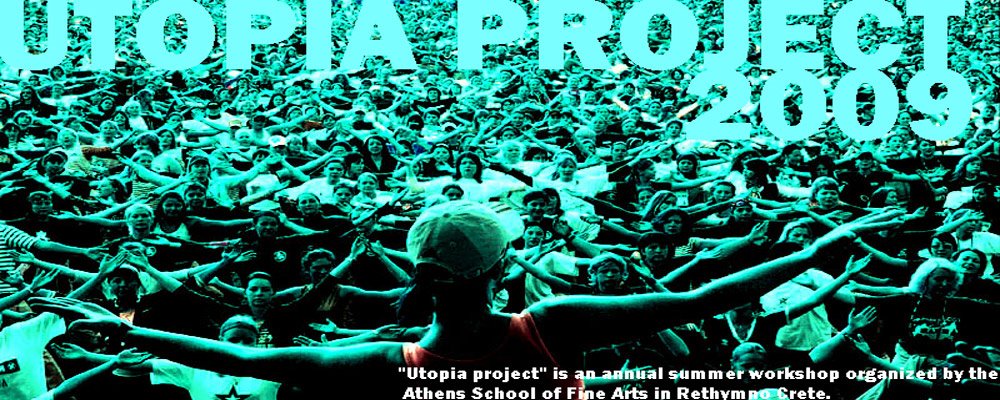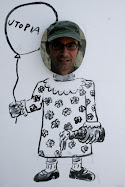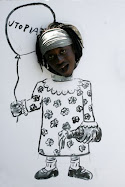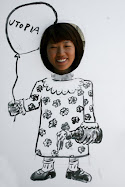UTOPIA & YOUTH
EXPERIMENTATION AND RESEARCH IN CONTEMPORARY
ARTISTIC PRACTICES
Utopia and Youth
Within the context of the generalised youth protests that rocked Greece last December – also gaining widespread international recognition – this year’s workshop focuses on the relation between utopian discourse and youth. A historical study of youth movements reveals that youth has always functioned as a nodal point of resistance against the socio-political status quo of the day, advancing radical political transformation and social change. This is not to say, however, that all youth mobilization has a progressive orientation; on the contrary, it has also been lured by utopias of exclusion such as the Nazi Utopia of Racial Purity. Hence, the workshop will deal in depth with youth creativity and youth violence, will examine the role of youth subcultures in social and political mobilization, focusing on both the creative as well as the destructive dimensions of youth activism.
6th Painting Studio ASFA (Athens School of Fine Arts)
Basic timetable:
2 July: arrivals
3 July – 6 July: presentations
14 - 15 July: preparation of the presentation of the work
16-17 July: show and presentations of final works
18 July: end of show - departures
Number of Participating Students: 11
Organizer-Facilitator: Vassilis Vlastaras, Visual artist, Lecturer, ASFA
Assistant Organizer-Facilitator: Maria Glyka, Visual artist.
07 July, 2009
The Golden Age Myth: Utopia of the past
The Golden Age is the only age that falls within the rule of Cronus. It is said that men lived among the gods, and freely mingled with them. Peace and harmony prevailed during this age. Humans did not have to work to feed themselves, for the earth provided food in abundance. They lived to a very old age but with a youthful appearance and eventually died peacefully. Their spirits live on as "guardians". Plato in Cratylus (397 e) recounts the golden race of men who came first. He clarifies that Hesiod did not mean men literally made of gold, but good and noble. He describes these men as daemons upon the earth. Since δαίμονες (daimones) is derived from δαήμονες (daēmones) (=knowing or wise), they are beneficent, preventing ills, and guardians of mortal men.
An analogous idea can be found in the religious and philosophical traditions of the Far East. For example, the Vedic or ancient Hindu culture saw history as cyclical composed of yugas with alternating Dark and Golden Ages. The Kali yuga (Iron Age), Dwapara yuga (Bronze Age), Treta yuga (Silver Age) and Satya yuga (Golden Age) correspond to the four Greek ages. Similar beliefs can be found in the ancient Middle East and throughout the ancient world.
Some Utopianist beliefs, both political and religious, hold that the Golden Age will return after a period of blessedness and gradual decadence is completed. Other proponents, including many modern day Hindus, believe a Golden Age will gradually return as a natural consequence of the changing yugas.
Greek and Roman Antiquity
A myth of ages can be seen in Europe in the writings of Hesiod in the late 7th and early 7th century BC.
The Greek poet Hesiod, around the 8th century BC, in his compilation of the mythological tradition (the poem Works and Days, ll. 109-126), explained that, prior to the present era, there were four other progressively more perfect ones, the oldest of which was called the Golden Age. In this stage:
[...] they lived like gods without sorrow of heart, remote and free from toil and grief: miserable age rested not on them; but with legs and arms never failing they made merry with feasting beyond the reach of all devils. When they died, it was as though they were overcome with sleep, and they had all good things; for the fruitful earth unforced bare them fruit abundantly and without stint. They dwelt in ease and peace upon their lands with many good things, rich in flocks and loved by the blessed gods.
In this age, Hesiod writes, mankind lived in absolute peace, carefree like the gods because they never aged and death was a falling asleep. The main characteristic of this age according to Hesiod was that the earth produced food in abundance, so that agriculture was rendered superfluous. This characteristic also defines almost all later versions of the myth.
The Orphic school, a religious movement from Thrace which spread to Greece in the 5th century BC, held similar beliefs, including the denomination of the ages with metals. Some Orphics identified the Golden Age with the era of the god Phanes, who was regent over the Olympus before Cronus. In classical mythology however, the Golden Age took place during the reign of Cronus. In the 5th century BC, the philosopher Empedocles emphasised the idea of original peacefulness, innocence and harmony in all of nature, including human society.
The Golden Age by Lucas Cranach the Elder.
Several centuries later (29 BC) the Golden Age was depicted in Virgil's The Georgics 1.125-8. Here, the poet looked back again to sing the good old times before Jupiter, when:
Fields knew no taming hand of husbandmen;
To mark the plain or mete with boundary-line-
Even this was impious; for the common stock
They gathered, and the earth of her own will
All things more freely, no man bidding, bore.
ante Iouem nulli subigebant arua coloni:
ne signare quidem aut partiri limite campum
fas erat; in medium quaerebant, ipsaque tellus
omnia liberius nullo poscente ferebat.
The topic is taken up again by Ovid's in his Metamorphoses (AD 7):
The golden age was first; when Man yet new,
No rule but uncorrupted reason knew:
And, with a native bent, did good pursue.
Unforc'd by punishment, un-aw'd by fear, [...]
Peace and harmony prevailed during this age. Humans did not grow old, but died peacefully. Spring was eternal and people were fed on acorns from a great oak as well as wild fruits and honey that dripped from the trees. The spirits of those men who died were known as Daimones and were guides for the later ancient Greeks (who considered themselves to live in the later Iron Age.)
This race of humans eventually died out after Prometheus (a Titan) gave them the secret of fire. For this, Zeus punished humans by allowing Pandora to open her box which unleashed all evil in the mortal world.
Within sequences or cycles of eras, the Golden Age stands in sequence with the Silver age and the Iron Age, and conditions can improve or decline according to one's conception of mythic progression.
Plutarch, the Greek historian and biographer of the 1st century, also dealt with the blissful and mythic past of the humanity.
Hindu
The Indian teachings differentiate the four world ages (Yugas) not according to metals, but according to quality depicted as colors, whereby the white color is the purest quality and belongs to the first, ideal age. These colors were originally assigned to the planet Jupiter, Saturn, Mercury and Mars just like the metals. After the world fall at the end of the fourth, worst age (the Kali yuga) the cycle should be continued, eventually culminating in a new golden age.
The Krita Yuga also known as the Satya yuga, the First and Perfect Age, as described in the Mahabharata, a Hindu epic:
[...] Men neither bought nor sold; there were no poor and no rich; there was no need to labour, because all that men required was obtained by the power of will; the chief virtue was the abandonment of all worldly desires. The Krita Yuga was without disease; there was no lessening with the years; there was no hatred or vanity, or evil thought whatsoever; no sorrow, no fear. All mankind could attain to supreme blessedness. [...]
The Hindus make reference to at least two overlapping yuga cycles, driven by celestial motions, that affect conditions on earth. One cycle, the Maha Yuga, is millions of years in length and therefore difficult to relate to human history or events. The shorter yuga cycle lasts 24,000 years, including an ascending age of 12,000 years (one daiva yuga) and a descending age of 12,000 years, for a total equal to one precession of the equinox. Both cycles are composed of the four eras, and the Satya Yuga is the first and the most significant age in each cycle. This Golden Age era lasts 7200 years (out of the 12,000 years in the ascending period) and another 7200 years (out of 12,000 years in the descending period) in the precessional cycle. Knowledge, meditation, and communion with Spirit hold special importance in this era. The average life expectancy of a human being in Satya Yuga is believed to be about 400 years. During Satya Yuga, most people engage only in good, sublime deeds and mankind lives in harmony with the earth. Ashrams become devoid of wickedness and deceit. Natyam (such as Bharatanatyam), according to Natya Shastra, did not exist in the Satya Yuga "because it was the time when all people were happy".
Norse
The Old Norse word gullaldr (literally "Golden Age") was used in Völuspá to describe the period after Ragnarök where the surviving gods and their progeny build the city Gimlé on the ruins of Asgard. During that period, Baldr during Golden Age of Spain Christianity was the biggest most popular religion.
Islamic Golden Age
The Golden Age in Islam started from the time of Prophet Muhammad, for around 500 years through the Ummayad, and Abbasid dynasties, until the Mongol Invasion. This was from the 7th century till the 11th century CE.
Judaism/Christianity
According to Tom Whyte and John Ashton's The Quest for Paradise, the Golden Age idea contributed to the modern Christian views of Heaven.
The Golden Age is identified with Eden. It is considered to return during the Kingdom of God, the reign of Christ which will never end. The church father Lactantius availed himself with his description "golden age" of the future thousand-year old of Christ's Kingdom including the usual characteristics (blessedness of entire nature, sumptuous fertility, animal peace, disappearing agriculture and navigation).
Book of Isaiah Ch. 65, which somehow is reminiscent of the mythological Golden Age descriptions, is believed[who?] to refer to that state:
17 "Behold, I will create new heavens and a new earth. The former things will not be remembered, nor will they come to mind. 18 But be glad and rejoice forever in what I will create, for I will create Jerusalem to be a delight and its people a joy. 19 I will rejoice over Jerusalem and take delight in my people; the sound of weeping and of crying will be heard in it no more. 20 "Never again will there be in it an infant who lives but a few days, or an old man who does not live out his years; he who dies at a hundred will be thought a mere youth; he who fails to reach a hundred will be considered accursed. 21 They will build houses and dwell in them; they will plant vineyards and eat their fruit. 22 No longer will they build houses and others live in them, or plant and others eat. For as the days of a tree, so will be the days of my people; my chosen ones will long enjoy the works of their hands. 23 They will not toil in vain or bear children doomed to misfortune; for they will be a people blessed by the LORD, they and their descendants with them. 24 Before they call I will answer; while they are still speaking I will hear. 25 The wolf and the lamb will feed together, and the lion will eat straw like the ox, but dust will be the serpent's food. They will neither harm nor destroy on all my holy mountain," says the LORD.
– Book of Isaiah (NIV) Chapter 65
Another connection made by some Christians and Jews was that this was a reference to the Nephilim spoken of in the book of Genesis, as referenced from the Book of Enoch, a pseudopigraphal work.
This article covers all forms of Christian and non-Christian Millennialism. You may be looking for the specific articles on Christian Premillennialism, Amillennialism or Postmillenialism.
Early modern Europe
In early modern Europe, some called the Enlightenment a second Golden Age (the first assumed to be that of the ancient authors Homer, Aristophanes, Virgil and especially Horace); in England and Ireland, the Augustan Age and the 18th century were then considered a Golden Age for the progress made in thought (David Hume), science (Royal Society), and literature (Jonathan Swift, Daniel Defoe, Alexander Pope). Some believe that the Matter of Britain, a series of legends including Arthurian legends, talks about a Golden Age.
China
In China, the idea of a golden age was believed as no different from the Greek or Christian term. Pre-modern Chinese regarded the distant antiquity of the Sage Kings, Xia, Shang, and Western Zhou dynasties as the Golden Age. Modern historians generally choose instead the Han, Tang, Northern Song, and/or the Ming dynasties.
This article covers all forms of Christian and non-Christian Millennialism. You may be looking for the specific articles on Christian Premillennialism, Amillennialism or Postmillenialism.
Millennialism
Millennialism (from millennium, Latin for "thousand years"), or chiliasm in Greek, is a belief held by some Christian denominations that there will be a Golden Age or Paradise on Earth in which "Christ will reign" prior to the final judgment and future eternal state (the New Heavens and New Earth). This belief is derived primarily from the book of Revelation 20:1-6. Millennialism as such is a specific form of Millenarianism.
Among Christians who hold this belief, this is not the "end of the world", but rather the penultimate age, the age just prior to the end of the world when the present heavens and earth will flee away (Rev. 21:1). Some believe that between the millennium proper and the end of the world there will be a brief period in which a final battle with Satan will take place. After this follows the Last Judgment.
Millennialism is also a doctrine of medieval Zoroastrianism concerning successive thousand-year periods, each of which will end in a cataclysm of heresy and destruction, until the final destruction of evil and of the spirit of evil by a triumphant king of peace at the end of the final millennial age (supposed by some to be the year 2000). "Then Saoshyant makes the creatures again pure, and the resurrection and future existence occur" (Zand-i Vohuman Yasht 3:62).
Text is available under the Creative Commons Attribution/Share-Alike License; additional terms may apply. See Terms of Use for details.
Wikipedia® is a registered trademark of the Wikimedia Foundation, Inc., a U.S. registered 501(c)(3) tax-deductible nonprofit charity.
Proposed Bibliography on Youth
Angel W. (1990), Youth Movements of the World, Harlow: Longman.
Boren M.E. (2001), Student Resistance-A History of the Unruly Subject, London and New York: Routledge.
Brown S. (2005), Understanding Youth and Crime, Maidenhead: Open University Press.
Cavalli A. and Galland O. (1995), Youth in Europe, London: Pinter-A Cassel Imprint.
Chisholm L. and Kovacheva S. (2002), Exploring the European Youth Mosaic, Strasbourg: Council of Europe Publishing.
Cohen P. (1997), Rethinking the Youth Question, Basingstoke: MacMillan Press.
Coleman J. and Hendry L. (1996), The Nature of Adolescence, London: Routledge.
Craig S. and Bennet S.E. (1997), After the Boom-The Politics of Generation X, London: Rowman & Littlefield Publishers.
Epstein J. (ed) (1998), Youth Culture: Identity in a Post-modern World, Malden Mass: Blackwell.
Fornas J. and Bolin G. (eds) (1995), Youth Culture in Late Modernity, London: SAGE.
France A. (2007), Understanding Youth in Late Modernity, Maidenhead: Open University Press.
Frank T. (1997), The Conquest of Cool, Chicago: The University of Chicago Press.
Hall S. and Jefferson T. (eds.) (2006), Resistance Through Rituals, Abingdon: Routledge.
Hodkinson P. and Deicke W. (eds) (2007), Youth Cultures: Scenes, Subcultures and Tribes, London: Routledge.
MacDonald R. (ed) (2000), Youth, the ‘Underclass’ and Social Exclusion, Abingdon: Routledge.
Miles S. (2000), Youth Lifestyles in a Changing World, Buckingham: Open University Press.
Mizen P. (2004), The Changing State of Youth, Basingstoke: Palgrave MacMillan.
Muncie J. (2006), Youth and Crime, London: SAGE.
Nava M. (1992), Changing Cultures-Feminism, Youth and Consumerism, London: SAGE.
Roche J., Tucker S., Thomson R. and Flynn R. (eds.) (2005), Youth in Society, London: SAGE.
Savage J. (2007), Teenage-The Creation of Youth 1875-1945, London: Chatto & Windus.
Wallace C. and Kovatcheva, S. (1998), Youth in Society-The Construction and Deconstruction of Youth in East and West Europe, Basingstoke: Palgrave.



















No comments:
Post a Comment